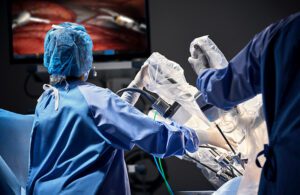
Intuitive Surgical SVP and Asia-Pacific (APAC) GM Glenn Vavoso [Photo courtesy of Intuitive Surgical]
China is the second-largest procedure market for Intuitive Surgical‘s da Vinci system and one of the fastest-growing markets for the surgical robotics developer.
But China’s been a tough country for medical device manufacturers due to the sales and supply chain challenges of COVID-19, the country’s volume-based procurement (VBP) policy, and home-grown competitors.
Glenn Vavoso, SVP and Asia-Pacific (APAC) GM at Intuitive Surgical — one of the world’s largest medical device companies – recently spoke with DeviceTalks Editorial Director Tom Salemi for the latest edition of Intuitive Talks.
DeviceTalks West: Intuitive President Dave Rosa will be a keynote speaker on Oct. 19
Here are just a few highlights from Vavoso on Intuitive’s experience and activities in China:
Doing business in China
“You’ve got to establish the clinical value first and foremost, and then for hospital executives — and maybe even moreso government officials and the officials that are over the health care system — what is ultimately the economic value that robotics might provide. That is no different in China,” Vavoso said. “I think maybe what other industries have experienced in China with changes in reimbursement policy or changes just in pricing and price controls, that has not yet sort of found its way to robotics in the same fashion. It’s still in many ways early days of adoption in China. They want to see the robotic healthcare industry be supported in these early times. And so where you see those general price controls happen where there are many competitors, it’s more of commodities and they’re looking to control health care costs.”
Growing da Vinci in China

Intuitive Surgical’s da Vinci surgical robotics system [Photo courtesy of Intuitive Surgical]
“Asia overall, the uptake has been good,” Vavoso said, adding that da Vinci has “been well validated by surgeons and societies.”
“In China, it is a market that historically has been tapped on how many systems can be imported and installed over a given period of time,” he continued. “They have a very carefully planned allocation plan for large medical equipment of which robotics fits into. And you have to go through a process of first making sure that the province gets a certain allocation of that, and then the hospitals then apply for that allocation, and they get the ability to move forward with their business plan to install a surgical robotic system. And so just like all the other geographies, we have a well-trained team that supports the hospitals, talks through the technology with surgeons.”
Intuitive Surgical’s Chinese infrastructure
“We operate through a partnership there. It’s a joint venture with Fosun Pharma,” Vavoso said. “It’s been a very good partner over the last six, seven years. [We are] building out some of our infrastructure there, which will include some manufacturing capability, some moderate research and development, and then training capability in an innovation center for surgeons. That build-out is underway in Shanghai.”
Related: Intuitive eyes sole-source suppliers as it expands capacity
Customer engagement in the COVID-19 era
“In some ways, it gave us a greater reach because you couldn’t meet face-to-face and we had to adapt to that, creating events and opportunities to share the value story and just the technology and even as we’re getting to launch products and getting centers ready for that, we had to do a lot of that remotely. It was just earlier this year that China finally opened up. It’s been a long run of not being able to travel into those countries or even for our own local teams to get out and about and get into the hospitals to support our customers, so we had to figure out how to do that very much in a remote way. It opened up, I think in many ways, the engagement of surgeons to us as a company, us to the surgeons and hospital executives, maybe in environments where you wouldn’t normally use that kind of remote technology, we’re seeing that very much a part of our routine now. You can expand your reach in a kind of a one-to-many fashion versus just a one-to-one. … For me, my personal reach was probably improved just over those three years. …Nothing beats face-to-face in this, but certainly having remote capability to be able to connect with video is a great addition.”
Listen to the entire conversation below or at DeviceTalks.com.